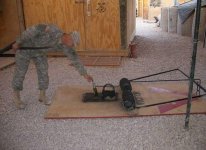While this discussion below deals with situational awareness as it pertains to self defense, the principals can also apply somewhat to your state of mind around machinery as well in my opinion.
Situational awareness is knowing what and who is around you and the potential threats they might pose. You assess the situation and people around you by gathering information, processing that information, and then figuring out if action is required. Situational awareness can help you avoid a fight or other harmful situation. Not only can situational awareness save your own life, but also other innocent lives around you. The military, the government, all law enforcement agencies and self-defense experts all train, use, and practice situational awareness.
Any time you are not asleep, you should be observing and evaluating what you are seeing. This will help you recognize a potential threat. There are three major ways to look at situational awareness. Colonel John Boyds OODA (observe, orient, decide, act), The United States government TEDD (time environment, distance, demeanor), and Colonel Jeff Coopers color codes.
Col. Jeff Coopers color codes are easy to understand and give us clear, measurable levels of how aware or unaware we are.
Code White
Code white is means you are completely unaware and tuned out. You should only be on code white when sleeping, but I bet if you think about it, you will find yourself tuned out quite a bit. All of the following are tune-out culprits: texting, talking on the phone, engrossed in a movie at the movie theater, sucked into the internet, a video game, a good book, or a TV Show, jamming out to good tunes in the car, if you have your headphones on too loud, or when you are busy concentrating on a work project. There are many times a day you may be 骰講ned out. Exhaustion and intoxication can cause you to tune out as well. I am guilty of tuning out when Im reading, watching a movie, or on road trips. How many times have I been driving, singing loudly to good tunes, when a friend calls and asks, where you? and I honestly dont know too many times.
Code Yellow
Code yellow is where we should be at all times, even at work and at home. Code yellow means we are on relaxed alert. This means you are aware of your surroundings and who is in them, but you have not spotted any threat. This relaxed awareness means that you are not expecting a fight, but accepting that a fight could happen and therefore not surprised if a threat presents itself. A perfect example of code yellow is when you are walking to your car in a parking lot, or down the street, or on the jogging trail. You are aware of how many people are behind you and beside you. You are aware of their pace and if that pace or position changes. You are in condition yellow if you always get your keys out of your pocket or purse before walking to the car. I was in code yellow when I had to go pick up a friend in a bad part of town and took note of the appearance and clothing of the three guys milling around the apartments entry gate.
Code Orange
Code orange, or f瑞ocused awareness is when you have spotted a potential threat. Code orange means you are ready to accept an attack. The NRA calls this level alert. You move from code yellow to code orange when you have stopped in the gas station for a drink and someone walks in wearing a long trench coat in the heat of summer. You stay focused on the potential threat, watching their every move, especially if they reach inside the coat. At this point you have assessed the situation and have decided what you will do if they pull out a gun and you are ready to move into code red.
Code Red
Code red is when you move into fight or flight mode, or high alert. This is when you will have to make the split second decision to defend yourself.
Others have added one more level, called black or comatose. This is when you have reached code red, but do not act. You have actually frozen and cannot do anything about the situation.
Global intelligence-gathering website STATFOR suggests situational awareness drills, such as memorizing people sitting at the bar of a restaurant you are dining at, noting the number of people standing in line at the movie theater, or trying to recall cars stopped at the same stop light. Another thing you should always do is note all the exits of any building you enter. At a bar or restaurant, always choose to sit facing the door. Do not ever put your back to the point of entry and exit. Not only does situational awareness involve observing and noting what is there, but also what is not there.
Criminals prey on easy targets, those who are distracted, vulnerable, and zombie-like in their routine. Even switching up your route to work once in a while helps deter crime. Walk with your head up, scanning the area around you. Walking with your head down means not only are you not aware of what is around you, but gives criminals a sign you are not confident, making you a vulnerable target.
One more point to situational awareness is to listen to your gut. Our instincts may not always be right, but they can be the first indication that something is wrong. Fear, anxiety, apprehension, and hesitation are all emotions that signal us that something is not right. We should listen to those emotions, if your hair stands on end suddenly, you might just need to move into code orange. When something just doesn't look right, it probably isn't.
Don遞 beat yourself up if you find yourself going code white, like all self-defense tactics, situational awareness takes practice.
